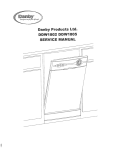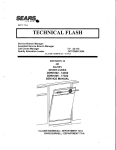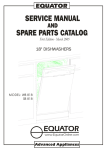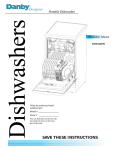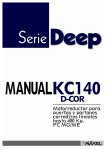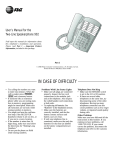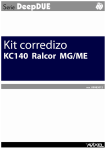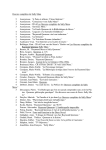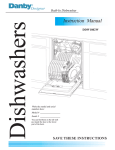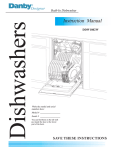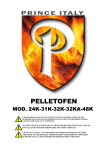Download Danby DDW1802 Service manual
Transcript
Danby Products Ltd. DDW1802 DDW1805 SERVICE MANUAL INDEX 1. PRODUCT SPECIFICATIONS 2. SCHEMATIC DIAGRAM 3. WIRING DIAGRAM 4. TIMER CYCLE CHART 5. COMPONENT OPERATION AND REPAIR 6. TROUBLE SHOOTING 7. PARTS LIST AND DIAGRAM SPECIFICATION MODEL Rating Motor (HP) Motor (Amps) Heater Wattage Wash Total Amps (Load Rated) Thermostat Contacts Close at DDW1802 and ELECTRICAL 120V 60Hz 1/5 1000W 9.2A 127°F ±5°F 58 ±3 WATER SUPPLY Suggested Min. Incoming Water 120°F to 150°F Temperature 49 to 66 Pressure (PSI) Minimum/Maximum 15/120 PSI Connection (NPT) 3/8” Consumption (Toil Gallons) 3.5±5% Water Valve Flow Rate (GPM) 1.08GPM±10% DDW1805 CLn Cont act of t i mer D/ Ed Di spenser EV1 Sol enoi d EV2 Wat er sof t ener I AQS Over f l ow swi t ch Power Swi t ch IG Door swi t ch IS I SS Reed swi t ch I TR Ther most at of heat er Power on l i ght LS LSS Sal t war ni ng l i ght Wash pump ML Ti mer MT Pr essur e swi t ch P0 Dr ai n pump PS Heat er R Ther most at of pump S T45 45℃ Ther most at T58 58℃ Ther most at RAPI D Rapi d wash PLUS I nt ensi ve wash I SB Reed swi t ch LSB Ri nse ai d war ni ng l i ght CODE NAME OF COMPONENT AC220- 230V/ 50Hz N F LS I SB I SS LSB LSS 3 1 2 EV2 b a B2 B5 a b B7 B1 b B6 EV1 B3 CL7 B3 3 CL8 1 B8 2 P1 CL6 I AQS A10 b PS S A8 CL1 A9 a IS A8 CL2 A6 b 4 PLUS 5 4 A7 a 6 1 A1 b 3 A3 CL3 A5 b 1 RAPI D T58 MT A3 D/ Ed CL4 A2 a PLUS3 2 T45 6 a RAPI D L IG DDW1802W AND DDW1805W Sch em at ic Diagr am of Dish wash er A4 a C C3 C3 b C5 ML S a C4 R a CL9 CL10 I TR( 78) b C1 L G N Power Swi t ch Bl ue Whi t e Whi t e Or ange Bl ack Bl ue Over f l ow Swi t ch Pi nk Pur pl e Br one Bl ack Gr ey Sal t Det ect i on Swi t ch Wat er Sof t ener Val ve Sky- bl ue Ri nse Ai d Det ect i on Swi t ch Bl ue Bl ack Power Ri nse No Sal t I ndi ct or I ndi ct or Ai d I ndi cat or Br one Sky- bl ue Sky- bl ue Br one Pur pl e Pi nk Whi t e C 5 B 5 4 3 4 3 6 2 1 2 1 6 2 1 8 7 4 3 B 10 9 A 5 8 7 Ti mer A 10 9 Red Red Bl ue Br one Pur pl e Whi t e Whi t e 58℃ Swi t ch Sky- bl ue Bl ue Bl ack Heat er 78℃ Swi t ch Bl ack Economi c Wash Swi t ch Pi nk Rapi d Wash Swi t ch Sky- bl ue Di spenser Red Red Or ange Br one Temi nal Pi nk Bl ue Red Wat er - l evel Swi t ch Whi t e Door Swi t ch Whi t e DDW1802W AND DDW1805W Wi r i ng Di agr am of Di shwasher Wash pump I nl et Val ve Dr ai n Pump 45℃ Swi t ch Whi t e Bl ue ci pa Ca r to 1 2 5 4 1 9 6 7 5 Fi xed Movi ng Cont . Cont . A A A A B B B B C C STEP TI ME OF PROGRAMME Wash Pump Heat er T45 Level T58 T45 EV1 Fi l l Ti mer Empt y Level EV2 Regener at i on EV1 Ref i l l Ext r a Dr ai n Ti mer Empt y Level Det er gent Ri nse Ai d Ther most at Ti mer Ful l Ther most at Ther most at 5 2 10 3 15 20 25 30 35 V+15″ P+15″ P+5. 5′ T+1′ 5. 5′ V+90″ / 2′ P+15″ P+5. 25′ T+30″ 5. 5′ 5. 5′ 5. 5′ V+2′ P+15″ P+5. 25′ 30″ P+15″ 5. 25′ V+90″ P+15″ P+5. 25′ 5. 5′ T+15″ T+5. 25′ 5. 5′ 5. 5′ V+90″ 15″ V+45″ 1′ 15″ 15″ 30″ 1′ 1′ ---- PROGRAMME FUNCTI ON 1 Dr ai n V- - - - Reset t i ng of Pr essur e Swi t ch P- - - - Set t i ng of Pr essur e Swi t ch T- - - - Set t i ng of Ther most at B A B A B A B A B A B A B A B A B A B A Fi xed Movi ng Cont . Cont . 10 9 6 7 5 4 1 2 SPECIFICATION: CAM No. 1 2 3 4 5 6 7 8 9 10 CAM No. 60 45 50 5 55 40 V+15″ P+15″ P+5. 5′ T+30″ V+90″ P+15″ P+5. 25′ 7. 5″ 97. 5″ T+5. 25′ 5. 5′ V+1′ 15″ V+45″ 30″ 15″ ---- 4 Dr ai n I nl et I nl et +Wash+Det er gent Wash+Heat ( 45/ 58) Dr ai n I nl et I nl et +Wash Wash+Heat +I nl et Wash+Heat +Regener at e Wash+Heat +Br i l l i ant ( 58) Pause Dr ai n I nl et Dr ai n I nl et Dr ai n St op P+15″ P+5. 25′ V+90″ ---- DDW1802W AND DDW1805W Pr ogr ame Cycl e of Di shwasher Dr ai n I nl et I nl et +Wash Wash+Heat ( 45) Wash Dr ai n I nl et I nl et +Wash+Det er gent Wash+Heat Wash Wash Wash Dr ai n I nl et I nl et +Wash Pause( Dr ai n) Pause( I nl et ) Wash( I nl et +Wash) Dr ai n I nl et I nl et +Wash Wash+Heat +Regener at e Wash+Heat +Br i l l i ant ( 45) Wash+Heat +Br i l l i ant ( 58) Pause Pause Dr ai n I nl et Dr ai n Pause Dr ai n I nl et Dr ai n Pause Dr ai n St op I nl et I nl et +Wash Dr ai n St op TIMER CYCLE CHART COMPONENT OPERATION AND REPAIR SAFETY PRECATIONS Always turn off the electric power supply before servicing any electrical component, making ohmmeter checks, or replacing any parts. All voltage checks should be made with a voltmeter having a full scale range of 130 volts or higher. After service is completed, be sure all safety-grounding circuits are complete, all electrical connections are secure, and all access panels are in place. TIMER With the timer, user selects the various cleaning cycles of the dishwasher. The timer controls all the electrical functions of the dishwasher in all stages of each cycle. All functions can be traced on the chart. Diagram provided in this service manual. To Test The Timer If the timer is suspected of faulty operation, reference timer chart and electrical schematic diagram and proceed as follows: 1. Index the timer to the first increment of the normal cycle, which is a drain period. 2. If the pump motor fails to operate during the first cycle increment, check for power at the pump motor connector block, if there is no power check the door latch switch, if there is power, check the pump motor as described in this section. 3. If the pump motor does operate, let the timer motor advance the timer through the drain increment to determine if the timer motor and drive train are fully operative. 4. Let the timer advance, or index it forward to the portion of the cycle in question. 5. If a component controlled by the timer fails to function as the timer advances through the cycle, check for voltage at the timer terminals. If the check voltage is supplied to the component, check the component as described in this section. Continuity through timer contacts, other controls, and wires can also be checked with an ohmmeter with electrical power disconnected. If the timers contacts fail to close in the sequence shown on the timer chart are burned (have resistance measurable with an ohmmeter), or if timer does not advance automatically, replace the timer. To Replace Timer 1. Disconnect dishwasher from electrical supply. 2. Remove the timer knob. Figure 1 Figure 2 3. Remove the screws which locking the control panel (See figure1). Remove the knob and unscrew the two screws which locking the timer on the control panel. (See Figure 2.) 4. Take down the damaged timer and install a new timer, reverse procedures to complete repairs. (See figure 3and 4.) TIMER Figure 3 Figure 4 DOOR LATCH AND SWITCH ASSEMBLY The latch and switch are located in the door assembly behind the control panel. The dishwasher will not operate until the door is closed; the latch engages the door catch. To Test Or Replace Door Switch. 1. Disconnect dishwasher from electrical supply. 2. Remove screws securing the control panel to the inner door (See Figure 1). 3. Remove wire leads from latch switch. 4. Use ohmmeter and check switch for continuity. 5. If the switch tests is good. Check dishwasher electrical power. Check to see if timer is defective. If switch is defective remove door switch from latch assembly. 6. Install new switch and reverse procedures to complete repairs. To Replace Door Latch Assembly 1. Disconnect dishwasher from electrical supply. 2. Remove screws securing the control panel to the inner door. 3. Remove wire leads from door latch and remove screws securing door latch assembly to inner door. (See Figure 5.) SCREW FLOAT SWITCH WIRE LEAD SWITCH DOOR LATCH WIRE LEAD Figure 5 Figure 6 4. Install new door latch assembly and reverse procedures to complete repairs. FLOAT SWITCH ASSEMBLY The water float assembly is located in the right lower side of the dishwasher (the portable located behind the lower front crosspiece). When too much water enter the dishwasher,the water will enter the float support through the overflow pipe, the float will make the floating switch acts, the electrical supply to the water valve will disconnected and the drain pump keep on working. If the switch fails to operate, check the following: ● Loose connection at the switch terminal. ● Switch not installed properly. ● Warped stem on float, not contacting the actuator blade. ● Float support restricts free float movement. ● Check if the float support is cracked. ● Food or foreign material restricting free float movement. ● If the rubber cap lost(See figure7). RUBBER CAP Figure 7 To Remove Or Replace Float Switch 1. Disconnect dishwasher from electrical supply. 2. Remove electrical leads to float switch. 3. Take down the switch from float support. 4. Install new float switch and reverse procedures to complete repairs (See figure 6). TROUBLESHOOTING The troubleshooting cheek list is common for all dishwasher models. They use different parts to accomplish the same thing and diagnosis will remain similar. When a problem arises, and a possible cause is listed, follow the test, remove or replace procedures as outline in this service manual. The wiring diagram, shematic and timer cycle chat is a necessity when making electrical checks. In most cases an ohmmeter will handle all the tests necessary. For checking any particular cycle of operation, it absolutely necessary that the cycle be set up as outlined in the product owner’s guide. SYMPTOM CHECK THE FOLLOWING REMENDY ●fuse (blow nor tripped) ●Supply line receptacle, wiring harness. ●Timer (contacts open or burnt). ●Motor (inoperative, check resistances). ●Door switch (open contacts) ●Door latch not making contact with door switch. Replace fuse or reset breaker. Repair or replace. Dishwasher stop washing but draining ● Overflow occur. Water can’t pour out from float support when pull out the rubber cap. Dishwasher runs but not heat ● Hole in the float supply is jammed. Check the reason of overflow pull out the rubber cap wait for a minute let water pour out. Suck with dust cleaner or other let water pour out. Dishwasher will not operation when turn on Dishwasher will not stop. Dishwasher runs with door open Motor hums but will not start or run. Motor trips out on in terminal thermal overload protector. ●heater element (open). ●Timer contacts (open or burnt). ●Wiring or terminal (burnt or broken). ● Thermostat is closed. ●Timer motor (inoperative). ●Wiring or terminal (burnt or broken). ●Timer (open or burnt contact). ●Defective door safety switch. ●Start winding(open). ●Motor (bad bearings or locked rotor). ●Start relay not dropping out. ●Improper voltage. ●Seal faces binding. ●Motor shaft binding. ●Motor windings shorted. ●Glass or foreign items in pump. Replace timer. Replace motor. Replace door switch. Replace or adjust to make contact. Replace heater element. Replace timer. Repair or replace. Replace. Replace timer. Repair or replace. Replace timer. Replace door safety switch. Replace motor. Replace motor. Replace start relay. Check voltage. Repair or replace. Repair or replace. Repair motor. Clean and clear area. Repeated cycles dishwasher Timer does not advance automatically. Dishwasher will not fill with water. Incomplete water fill. Too much water fill. Dishwasher will not pump out. Water siphons out. Water leaks. ●Timer (contacts open or burnt) ●Motor (inoperative, check resistances). ●Timer motor (stalled or open). ●Check timer for power to timer motor. ●Timer shaft binding or knob interference to escutcheon. ●Water supply turns off. ●Defective inlet valve. ●Check valve screen for obstructions. ●Defective float switch. ●Timer contacts (open or burnt). ●Wiring (broken or burnt). ●Low water pressure. ●Clogged water inlet valve screen. ●Timer advanced past start of fill cycle. ●Heavy water supply usage elsewhere in home. ●Kinked or restricted fill hose, water inlet valve to fill tunnel. ●Water inlet fill valve defective. ●Timer contacts (open or burnt). ●Float arm binding or out of adjustment. ●Possibility customer/user turned timer past drain cycle. ●Drain pump is restricted. ●Damaged impeller. ●Wiring or terminal (contacts open or burnt). ●Drain hose loop to low. ●Drain line connected to a floor drain not vented. ●Spray arm not rotating or split. ● Poor wash ability. Overcharge of water. ●Tub seal (torn, worn or loose). ●Dishwasher door not sealing properly. ●Dishwasher is not level. ●Overburden (wrong type of detergent). ●Hose clamps loose. ●Heater element mounting nuts loose. ●Water seal leaking. ●O-ring is not in position. ●Motor and pump assembly not seated proper in tub liner bottom. ●Spray arm not rotating. ●Improper loading of dishes, pans and other. ●Detergent dispenser inoperative. ●Insufficient amount of detergent. Or the detergent is old. ●Damaged or the impeller is broken. ●Detergent not dissolve. Replace timer. Replace timer. Replace timer. Replace timer. Repair or adjust. Turn water supply on. Replace inlet valve. Disassemble and clean screen. Replace switch. Replace timer. Repair or replace. Minimum water pressure of 15P.S.I Clean water inlet valve screen. Instruct customer/user to turn timer dial to start indicator mark. Use dishwasher when water usage is at a minimum. Correct as needed. Replace water inlet fill valve. Replace timer. Repair, adjust or replace. Instruct customer/user. Clear restrictions. Replace drain pump. Replace timer. Move to proper height. Install vent air gap at counter top. Check for proper rotation or replace spray arm. Check and correct for proper fill. Replace tub seal. Adjust door latch assembly and/or strike. Level dishwasher properly. Instructs customer/user. Tighten all clamps securely. Tighten the nut. Use a new water seal. Adjust the ring or replace a new. Replace seal. Check for proper rotation. Instructs customer/user on proper loading per owner’s guide. Repair or replace dispenser. On proper amount of fresh deter gent to use. Replace pump assembly. Incoming water temperature of 140°F is required to proper dissolve detergent. Poor drying of dishes Detergent cup will not open. Door will not lath. Rinse agent liquid will not eject. Rinse agent liquid leaks. Noisy pump assembly. Dishwasher continues fill or continues to even though in case there is no voltage to valve. Detergent left dispenser. Softener leaking Leaking form air inlet. ●Improper loading of dishes, pots and other. ●Heating element (open). ●Incoming water temperature too low. ●Wiring or terminal (broken or burnt). ●Cup binding. ●Roll pin retainer or shaft broken. ●Defective bi-metal. ●Timer contact (open or broken). Door latch damaged. ●Electromagnetic valve defective. ●Rinse agent dispenser not mounted correctly. ●Plunger stuck or held in closed position. ●Container cracker or broken. ●Defective seal on plunger. ●Over filling container. ●Impellers not properly shimmed or rubbing. to fill of fill in ●Pump parts not properly installed. ●Debris in bottom of tub sump area. ●Defective motor bearings. ●Something (dirt or foreign material) under diaphragm in water inlet valve. ●Defective water inlet fill valve. ●Detergent cup held or blocked by large dishes. ●Dispenser wet when detergent was added. ●Softener broken. ●Softener nut loosen. ●Air inlet nut loose. ●Air inlet install up side down. Instruct customer/user on proper loading per owner’ s guide. Replace heating element. Incoming water temperature of 140°F for best drying results. Replace or repair. Repair or replace. Replace pin, retainer or shaft. Repair or replace. Replace timer. Replace door latch. Replace valve. Mount securely to rear of inner door panel. Free plunger or adjust plunger release. Replace container. Replace plunger. Follow instructions in owner’s manual. Use shim gauge furnished in impeller and seal kit, when seals are properly shimmed the impellers will be in correct operating position. Inspect and correct. Clean out sump area. Replace motor. Clean water replace. inlet valve Replace water inlet valve. On proper loading dishes. Instructs customer/user. Replace softener. Screw down softener cap. Screw down air inlet nut. Reinstall air inlet properly. or ext ernal hose O-ri ng nut gui de casi ng f eedi ng di spenser wat er hose f or upper sprayer assembl y t op sprayi ng nozzl e O-ri ng connect or f or t op sprayer nozzl e pi pe f or t op sprayi ng nozzl e ri ng nut f or f ast eni ng l ower mani f ol d mot or pump assembl y ri ng nut of ai r breaker f i l t er assembl y upper sprayer l ower sprayer connect i ng ri ng nut l ower sprayer shi f t microf i l er l ower mani f ol d support cup cl ampi ng ri ng nut connect i ng duct f or ext ernal hose O-ri ng t hermost at assembl y ai r breaker assembl y cup gasket ai r i nl et cup assembl y ri ng nut of ai r breaker drai n pump PVC hose f or pessure swi t ch O-ri ng connect i ng duct i nl et hose of ai r breaker pressure swi t ch drai n hose of ai r breaker sal t channel regenerat i on hose sof t ener cap assembl y heat i ng el ement s sof t ener ri ng nut ri ng nut M8 O-ri ng f or gui de rai l bracket sof t ener gasket coupl i ng casi ng f or prot ect i on t hermost at t hermost at prot ect i on i nl et val ve drai n hose adj ust abl e sof t ener i nner door pi l ot l amp but t on power swi t ch 6 1 monopol ar cont rl swi t ch bi -pol ar cont rol swi t ch handl e assembl y t i mer cont rol panel knob knob panel out er door door spri ng hi nge assembl y det ergent di spenser door edge guard pol yst yrene l ef t hi nge assembl y ri ght hi nge assembl y sound i nsul at i on f i ber f l oat suppor t l evel i ng l eg t ub band assembl y l ef t upr i ght s assembl y l ower f r ont cr osspi ece l owr r ear cr osspi ece f oot r est assembl y j unct i on box door l ock hook and coupl i ng bl ock baseboar d upper f r ont cr osspi ece gui de r ai l br acket assembl y f l oat suppor t assembl i ng hook gui de r ai l gui de r ai l bl ock r i ght upr i ght s assembl y cut l er y basket l ower basket assembl y uper basket assembl y cup r ack of upper basket















